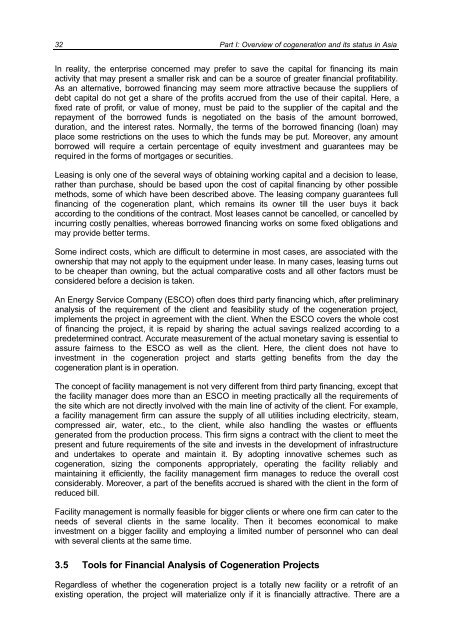part 1: overview of cogeneration and its status in asia - Fire
part 1: overview of cogeneration and its status in asia - Fire
part 1: overview of cogeneration and its status in asia - Fire
You also want an ePaper? Increase the reach of your titles
YUMPU automatically turns print PDFs into web optimized ePapers that Google loves.
32 Part I: Overview <strong>of</strong> <strong>cogeneration</strong> <strong>and</strong> <strong>its</strong> <strong>status</strong> <strong>in</strong> Asia<br />
In reality, the enterprise concerned may prefer to save the capital for f<strong>in</strong>anc<strong>in</strong>g <strong>its</strong> ma<strong>in</strong><br />
activity that may present a smaller risk <strong>and</strong> can be a source <strong>of</strong> greater f<strong>in</strong>ancial pr<strong>of</strong>itability.<br />
As an alternative, borrowed f<strong>in</strong>anc<strong>in</strong>g may seem more attractive because the suppliers <strong>of</strong><br />
debt capital do not get a share <strong>of</strong> the pr<strong>of</strong><strong>its</strong> accrued from the use <strong>of</strong> their capital. Here, a<br />
fixed rate <strong>of</strong> pr<strong>of</strong>it, or value <strong>of</strong> money, must be paid to the supplier <strong>of</strong> the capital <strong>and</strong> the<br />
repayment <strong>of</strong> the borrowed funds is negotiated on the basis <strong>of</strong> the amount borrowed,<br />
duration, <strong>and</strong> the <strong>in</strong>terest rates. Normally, the terms <strong>of</strong> the borrowed f<strong>in</strong>anc<strong>in</strong>g (loan) may<br />
place some restrictions on the uses to which the funds may be put. Moreover, any amount<br />
borrowed will require a certa<strong>in</strong> percentage <strong>of</strong> equity <strong>in</strong>vestment <strong>and</strong> guarantees may be<br />
required <strong>in</strong> the forms <strong>of</strong> mortgages or securities.<br />
Leas<strong>in</strong>g is only one <strong>of</strong> the several ways <strong>of</strong> obta<strong>in</strong><strong>in</strong>g work<strong>in</strong>g capital <strong>and</strong> a decision to lease,<br />
rather than purchase, should be based upon the cost <strong>of</strong> capital f<strong>in</strong>anc<strong>in</strong>g by other possible<br />
methods, some <strong>of</strong> which have been described above. The leas<strong>in</strong>g company guarantees full<br />
f<strong>in</strong>anc<strong>in</strong>g <strong>of</strong> the <strong>cogeneration</strong> plant, which rema<strong>in</strong>s <strong>its</strong> owner till the user buys it back<br />
accord<strong>in</strong>g to the conditions <strong>of</strong> the contract. Most leases cannot be cancelled, or cancelled by<br />
<strong>in</strong>curr<strong>in</strong>g costly penalties, whereas borrowed f<strong>in</strong>anc<strong>in</strong>g works on some fixed obligations <strong>and</strong><br />
may provide better terms.<br />
Some <strong>in</strong>direct costs, which are difficult to determ<strong>in</strong>e <strong>in</strong> most cases, are associated with the<br />
ownership that may not apply to the equipment under lease. In many cases, leas<strong>in</strong>g turns out<br />
to be cheaper than own<strong>in</strong>g, but the actual comparative costs <strong>and</strong> all other factors must be<br />
considered before a decision is taken.<br />
An Energy Service Company (ESCO) <strong>of</strong>ten does third <strong>part</strong>y f<strong>in</strong>anc<strong>in</strong>g which, after prelim<strong>in</strong>ary<br />
analysis <strong>of</strong> the requirement <strong>of</strong> the client <strong>and</strong> feasibility study <strong>of</strong> the <strong>cogeneration</strong> project,<br />
implements the project <strong>in</strong> agreement with the client. When the ESCO covers the whole cost<br />
<strong>of</strong> f<strong>in</strong>anc<strong>in</strong>g the project, it is repaid by shar<strong>in</strong>g the actual sav<strong>in</strong>gs realized accord<strong>in</strong>g to a<br />
predeterm<strong>in</strong>ed contract. Accurate measurement <strong>of</strong> the actual monetary sav<strong>in</strong>g is essential to<br />
assure fairness to the ESCO as well as the client. Here, the client does not have to<br />
<strong>in</strong>vestment <strong>in</strong> the <strong>cogeneration</strong> project <strong>and</strong> starts gett<strong>in</strong>g benef<strong>its</strong> from the day the<br />
<strong>cogeneration</strong> plant is <strong>in</strong> operation.<br />
The concept <strong>of</strong> facility management is not very different from third <strong>part</strong>y f<strong>in</strong>anc<strong>in</strong>g, except that<br />
the facility manager does more than an ESCO <strong>in</strong> meet<strong>in</strong>g practically all the requirements <strong>of</strong><br />
the site which are not directly <strong>in</strong>volved with the ma<strong>in</strong> l<strong>in</strong>e <strong>of</strong> activity <strong>of</strong> the client. For example,<br />
a facility management firm can assure the supply <strong>of</strong> all utilities <strong>in</strong>clud<strong>in</strong>g electricity, steam,<br />
compressed air, water, etc., to the client, while also h<strong>and</strong>l<strong>in</strong>g the wastes or effluents<br />
generated from the production process. This firm signs a contract with the client to meet the<br />
present <strong>and</strong> future requirements <strong>of</strong> the site <strong>and</strong> <strong>in</strong>vests <strong>in</strong> the development <strong>of</strong> <strong>in</strong>frastructure<br />
<strong>and</strong> undertakes to operate <strong>and</strong> ma<strong>in</strong>ta<strong>in</strong> it. By adopt<strong>in</strong>g <strong>in</strong>novative schemes such as<br />
<strong>cogeneration</strong>, siz<strong>in</strong>g the components appropriately, operat<strong>in</strong>g the facility reliably <strong>and</strong><br />
ma<strong>in</strong>ta<strong>in</strong><strong>in</strong>g it efficiently, the facility management firm manages to reduce the overall cost<br />
considerably. Moreover, a <strong>part</strong> <strong>of</strong> the benef<strong>its</strong> accrued is shared with the client <strong>in</strong> the form <strong>of</strong><br />
reduced bill.<br />
Facility management is normally feasible for bigger clients or where one firm can cater to the<br />
needs <strong>of</strong> several clients <strong>in</strong> the same locality. Then it becomes economical to make<br />
<strong>in</strong>vestment on a bigger facility <strong>and</strong> employ<strong>in</strong>g a limited number <strong>of</strong> personnel who can deal<br />
with several clients at the same time.<br />
3.5 Tools for F<strong>in</strong>ancial Analysis <strong>of</strong> Cogeneration Projects<br />
Regardless <strong>of</strong> whether the <strong>cogeneration</strong> project is a totally new facility or a retr<strong>of</strong>it <strong>of</strong> an<br />
exist<strong>in</strong>g operation, the project will materialize only if it is f<strong>in</strong>ancially attractive. There are a









